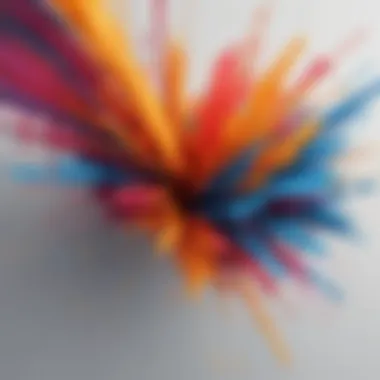Mastering the Art of Graphic Design: A Pro's In-Depth Guide


Industry Overview
Graphic design is a dynamic field that plays a crucial role in visual communication and branding strategies for businesses. With the ever-evolving digital landscape, professionals in this industry are constantly challenged to stay updated with the latest trends and technologies. Understanding industry-specific software is paramount for designers to deliver high-quality design solutions efficiently.
Vyond is a popular software provider within the animation and multimedia industry, offering cutting-edge tools for creating engaging visual content. Toon Boom Harmony is another industry favourite known for its advanced features in animation production. Given the diverse landscape of graphic design software, buyers often face challenges in selecting the most suitable option for their specific needs.
Emerging technologies like artificial intelligence and virtual reality are revolutionizing the graphic design industry. AI-powered design tools are streamlining repetitive tasks, enhancing productivity, and allowing for more creative exploration. Today's designers must adapt to these technological advancements to maintain a competitive edge in the market.
Top Software Options
When it comes to selecting graphic design software, having a comprehensive understanding of the leading providers is essential. Adobe Creative Cloud stands out as a powerhouse in the industry, offering a wide range of tools for graphic design, photo editing, and web development. CorelDRAW Graphics Suite is another popular choice known for its vector illustration capabilities and graphic design features.
Comparing features across different software solutions is crucial for decision-makers looking to invest in the best option. Adobe Creative Cloud offers a subscription-based pricing model, providing users with access to the entire suite of Adobe products. On the other hand, Sketch is a vector graphics editor popular for its ease of use and collaboration features.
Considering pricing structures is imperative for businesses aiming to optimize their expenses while maximizing the value derived from graphic design software. Understanding the various subscription plans, licensing options, and additional costs associated with support and updates is essential for making an informed decision.
Selection Criteria
Navigating the selection process for graphic design software requires careful consideration of multiple factors. Design professionals must evaluate aspects such as functionality, usability, scalability, and compatibility with existing workflows. Considering user feedback and reviews can offer valuable insights into the performance and reliability of different software solutions.
Avoiding common mistakes during the software selection process is crucial for saving time and resources. Some common pitfalls include overlooking compatibility issues with existing hardware, neglecting to assess long-term scalability, and underestimating the importance of user training and technical support.
Determining the right fit for your business needs involves aligning software capabilities with strategic objectives and operational requirements. Customizing software configurations to match specific design workflows can enhance efficiency and streamline collaboration among team members.
Implementation Strategies
Implementing graphic design software successfully requires following best practices to ensure a seamless transition and optimal utilization of the tools. Design teams should create a detailed implementation plan outlining key milestones, timelines, and resource allocation for the software deployment.
Integrating new software with existing systems and processes is essential for maintaining workflow continuity and data integrity. Conducting compatibility tests and pilot runs can help identify and resolve any potential integration issues before full deployment.
Providing adequate training and support resources to users is critical for maximizing software adoption and proficiency. Offering hands-on training sessions, access to online tutorials, and continuous technical assistance can empower designers to leverage the full potential of the software effectively.
Future Trends
The future of the graphic design industry holds exciting possibilities driven by advancing technologies and evolving user demands. Augmented reality and immersive design experiences are expected to shape the industry landscape, offering new avenues for creative expression and audience engagement.
Anticipating upcoming technologies such as machine learning algorithms and 3D rendering tools can help businesses stay ahead of the curve and leverage innovative solutions for design projects. By embracing emerging trends and investing in future-proofing technology stacks, designers can position themselves for long-term success in a rapidly evolving digital environment.
Recommendations for future-proofing technology stacks include diversifying software portfolios, fostering a culture of continuous learning and innovation, and proactively seeking opportunities to leverage cutting-edge tools and techniques. By staying agile and adaptive to industry changes, graphic designers can navigate challenges and capitalize on emerging trends to drive growth and innovation.


Introduction
Graphic design is not just about creating visually appealing images; it is a blend of art and science that holds significant importance in today's competitive market. This section serves as the gateway to understanding the multifaceted world of graphic design. By exploring key elements, benefits, and considerations, readers will gain valuable insights into the fundamental principles that underpin this dynamic field. From the origins of visual communication to the modern role of graphic designers, this introduction sets the stage for an in-depth exploration of graphic design mastery.
Understanding Graphic Design
In delving into the realm of graphic design, one encounters the intricate interplay between aesthetics and functionality. The art and science of visual communication, a cornerstone of graphic design, serve as a vehicle for conveying messages effectively and aesthetically. Understanding the evolution of graphic design unveils the transformative journey from traditional to digital mediums. Moreover, grasping the multifaceted role of a graphic designer sheds light on the diverse skill set required to navigate the demands of this profession.
The Art and Science of Visual Communication
The art and science of visual communication encapsulate the essence of graphic design, blending creativity with strategic thinking. This aspect emphasizes the vital role of design in conveying messages with impact and clarity. The intersection of artistry and communication skills distinguishes visual communication as a linchpin in the creative process. Leveraging visual elements to communicate ideas succinctly and persuasively forms the crux of this foundational concept in graphic design.
The Evolution of Graphic Design
The evolution of graphic design mirrors the broader technological advancements influencing visual aesthetics and communication. From the traditional hand-drawn illustrations to the digital revolution, graphic design has undergone a paradigm shift. This evolution highlights the adaptability and innovation essential for graphic designers to stay relevant in a rapidly evolving landscape. Embracing digital tools and techniques while honoring traditional artistic principles marks a strategic approach to navigating the evolution of graphic design.
The Role of a Graphic Designer
Central to the graphic design ecosystem is the pivotal role of a graphic designer in translating concepts into visually compelling narratives. The graphic designer's ability to synthesize creativity, technical proficiency, and client requirements defines their substantial contribution to various industries. Balancing artistic vision with client objectives, graphic designers wield their expertise to create captivating visual solutions. Exploring the challenges and rewards of being a graphic designer unveils a dynamic profession that requires adaptability, innovation, and a keen eye for detail.
Skill Mastery
In the realm of graphic design, skill mastery is the cornerstone of success. Understanding the importance of honing one's skills is crucial for professional growth. Mastery of design fundamentals such as typography, color theory, and layout enables designers to communicate effectively through visuals. By delving into the intricacies of these elements, designers can create compelling and impactful designs that resonate with audiences. Moreover, skill mastery empowers designers to push creative boundaries, staying ahead of trends and innovations in the industry. It also instills confidence in their abilities, leading to a stronger portfolio and distinctive style. Therefore, aspiring graphic designers must prioritize skill mastery to excel in their craft and reach the pinnacle of success.
Design Fundamentals
Typography and Fonts
Typography and fonts play a pivotal role in graphic design by conveying messages and evoking emotions. The choice of typeface, font size, and spacing can significantly impact the overall aesthetics and readability of a design. Understanding the nuances of typography is essential for creating visually appealing and harmonious compositions. Designers must consider factors such as hierarchy, contrast, and alignment to effectively communicate their intended message. Utilizing unique and appropriate fonts can help establish brand identity and evoke specific moods or associations within a design.
Color Theory
Color theory is a fundamental aspect of graphic design that influences emotions, perceptions, and brand identity. By understanding the interplay of colors, designers can create visually striking and harmonious compositions. Different colors evoke varied responses and can be used strategically to convey messages or evoke desired emotions. Comprehending the principles of color harmony, contrast, and saturation is essential for creating impactful designs that resonate with the target audience.
Layout and Composition
Layout and composition are essential elements in graphic design that dictate the visual hierarchy and flow of information. A well-structured layout enhances readability and guides the viewer's eye through the design. Designers must consider factors such as balance, proximity, and white space to create cohesive and engaging compositions. Experimenting with different layouts and compositions allows designers to develop their unique style and create visually compelling designs that effectively communicate the intended message.
Software Proficiency
Illustrator


Illustrator is a versatile vector graphics editor that enables designers to create scalable and high-quality illustrations, logos, icons, and typography. Its robust tools and capabilities empower designers to bring their creative vision to life with precision and flexibility. By mastering Illustrator, designers can create intricate artwork, streamline workflow, and collaborate seamlessly with other Adobe Creative Cloud applications.
Photoshop
Photoshop is a powerful raster graphics editor that offers a myriad of tools for photo editing, compositing, and digital painting. Its extensive features and capabilities make it a preferred choice for designers working on image manipulation and visual effects projects. From retouching photographs to creating intricate digital artwork, Photoshop enables designers to unleash their creativity and transform ideas into stunning visual representations.
InDesign
InDesign is a desktop publishing software that specializes in layout design, typesetting, and document preparation. Designers use InDesign to create print-ready publications such as books, magazines, brochures, and PDF files. Its robust layout tools and precise typography controls make it an essential tool for organizing content and creating visually appealing layouts. By mastering InDesign, designers can produce professional-quality print materials and digital publications with ease and efficiency.
Creativity and Innovation
Generating Ideas
Generating ideas is a creative process that fuels innovation and drives design forward. By exploring diverse sources of inspiration and experimenting with different techniques, designers can uncover unique solutions to design challenges. Encouraging a culture of brainstorming and ideation within design teams fosters creativity and collaboration, leading to the development of fresh and innovative design concepts.
Staying Inspired
Staying inspired is essential for maintaining creative momentum and overcoming creative blocks. Designers can stay inspired by exploring art, design, nature, and diverse cultural influences. Seeking inspiration from various sources enriches the creative process and helps designers develop a unique design perspective. By cultivating a curious and open-minded approach to design, designers can stay motivated and continually push the boundaries of creativity.
Pushing Boundaries
Pushing boundaries is a mindset that fuels innovation and drives design excellence. By challenging conventional design norms and experimenting with unconventional techniques, designers can break new ground and create groundbreaking designs. Embracing risk-taking and embracing failure as a stepping stone to success empowers designers to push beyond their comfort zones and explore new possibilities. Pushing boundaries not only drives personal growth but also propels the design industry forward by shaping future trends and setting new standards of creativity and innovation.
Professional Development
In this section, we delve deep into the crucial aspect of professional development in the realm of graphic design. Professional development holds immense significance as it plays a pivotal role in honing and refining skills required for excelling in this competitive field. It serves as a pathway for graphic designers to enhance their expertise, stay updated with industry trends, and evolve creatively. Through continuous learning and growth opportunities, professionals can push their boundaries, expand their knowledge base, and establish themselves as leaders in the graphic design sphere. By focusing on specific elements like skill enhancement, ongoing education, and personal growth, individuals can elevate their careers and achieve new levels of success within the industry.
Building a Portfolio
Curating Projects
Curating projects is a fundamental aspect of building a compelling portfolio that showcases a designer's capabilities and unique style. It involves carefully selecting and presenting specific works that highlight proficiency in different design areas, such as branding, illustration, or web design. The key characteristic of curating projects lies in the ability to tailor the portfolio to reflect the designer's strengths and expertise effectively. By curating a diverse range of projects, designers can demonstrate versatility, creativity, and problem-solving skills to potential clients or employers. While this approach offers a comprehensive view of the designer's abilities, it is essential to balance the quantity and quality of projects to ensure a well-rounded and impactful portfolio.
Showcasing Diverse Skills
Showcasing diverse skills within a portfolio is essential for standing out in the competitive landscape of graphic design. This involves highlighting proficiency in various design areas, such as print design, digital media, or UXUI design, to demonstrate versatility and adaptability. The key characteristic of showcasing diverse skills is to present a range of projects that exhibit different techniques, styles, and approaches, showcasing the designer's ability to work across multiple platforms and formats. By showcasing diverse skills, designers can attract a broader range of clients or job opportunities and position themselves as well-rounded and competent professionals.
Client Work vs. Personal Projects


Understanding the balance between client work and personal projects is crucial for maintaining a successful graphic design career. Client work offers opportunities to collaborate with external stakeholders, meet specific project requirements, and gain valuable experience in real-world scenarios. On the other hand, personal projects provide creative freedom, experimentation, and a chance to explore passion projects outside commercial constraints. The unique feature of balancing client work and personal projects lies in finding the right equilibrium that allows designers to fulfill client needs while pursuing personal creative endeavors. By navigating this balance effectively, designers can enhance their portfolio with a mix of professional projects and personal explorations, showcasing their versatility and creative vision.
Industry Insights
Industry insights play a crucial role in the field of graphic design. As professionals navigate the dynamic landscape of design, staying abreast of emerging trends and innovations is paramount. Understanding the market demands and consumer preferences enables designers to create relevant and impactful visual solutions. Through industry insights, designers can anticipate shifts in design aesthetics, technologies, and client expectations, positioning themselves at the forefront of the industry.
Trends and Innovations
Responsive Design
Responsive design is a key aspect of adapting digital content to various devices and screen sizes. This adaptable approach ensures that websites and applications maintain usability and visual appeal across different platforms, contributing to a seamless user experience. The flexibility of responsive design allows designers to cater to the diverse browsing habits of modern users efficiently. While responsive design enhances accessibility and user engagement, its complexity may require additional resources for implementation.
Minimalism
Minimalism focuses on simplicity, utilizing negative space, clean lines, and limited color palettes to create sophisticated and uncluttered design compositions. This design approach emphasizes essential elements, conveying messages concisely and elegantly. The minimalist aesthetic appeals to modern audiences seeking clarity and sophistication in visual communication. However, achieving effective minimalism requires a keen eye for detail and a deep understanding of visual hierarchy.
Augmented Reality
Augmented reality integrates digital elements into the real world, providing interactive and immersive experiences for users. By overlaying virtual information onto physical environments, augmented reality enhances engagement and storytelling possibilities in graphic design. This innovative technology opens avenues for creativity, allowing designers to craft compelling narratives and dynamic visuals. Despite its potential for enhancing user experiences, augmented reality implementation may require specialized expertise and resources.
Collaboration and Networking
Joining Design Communities
Engaging in design communities offers designers opportunities for knowledge sharing, collaboration, and inspiration. By joining online forums, attending design events, and participating in workshops, professionals can expand their skill sets and stay updated on industry trends. Design communities foster a sense of camaraderie and professional growth, opening doors to new perspectives and creative partnerships. However, maintaining active participation in communities may demand time and effort, balancing personal projects with community engagement.
Attending Conferences
Attending design conferences provides an avenue for networking, learning from industry leaders, and gaining insights into the latest design practices. These events offer exposure to diverse perspectives, innovative techniques, and emerging technologies, enriching designers' professional development. Conferences also provide opportunities for showcasing work, receiving feedback, and establishing connections within the design community. While conference attendance can be enriching, it requires careful selection to align with specific learning goals and interests.
Utilizing Online Platforms
Online platforms serve as hubs for professional networking, portfolio showcasing, and collaboration in the design industry. Platforms like Behance, Dribbble, and LinkedIn offer designers a space to connect with peers, share projects, and explore job opportunities. Leveraging online platforms enhances visibility, credibility, and accessibility to potential clients and collaborators. However, managing online presence effectively requires strategic planning, content curation, and consistent engagement.
Client Industries
Advertising
Advertising design involves creating visual campaigns to promote products, services, or brands to target audiences. Effective advertising design captures audience attention, conveys brand messaging, and drives consumer actions. Leveraging creativity, market research, and design strategies, advertisers craft visually compelling narratives to influence consumer behavior. While advertising design offers creatives a platform for innovation and storytelling, meeting client expectations and campaign objectives is paramount.
Web Design
Web design focuses on creating visually engaging and functional websites that enhance user experiences and achieve business goals. Designers incorporate layout principles, navigation structures, and visual hierarchy to optimize user interactions and conversions. Implementing responsive design, accessibility features, and user-centric interfaces are critical aspects of web design. Balancing aesthetic appeal with usability, designers strive to create intuitive and seamless online experiences for visitors. However, adapting to evolving web technologies and user preferences requires continuous learning and adaptation.
Print Media
Print media design encompasses creating visuals for printed materials such as brochures, magazines, posters, and packaging. Designers must consider layout, typography, color schemes, and print specifications to produce appealing and effective print collateral. Print media design allows for tactile and meaningful interactions with physical materials, reinforcing brand identities and messaging. Despite the digital shift, print media remains a significant medium for visual storytelling and branding. However, working within the constraints of print processes and formats poses challenges that necessitate attention to detail and precision in design execution.



